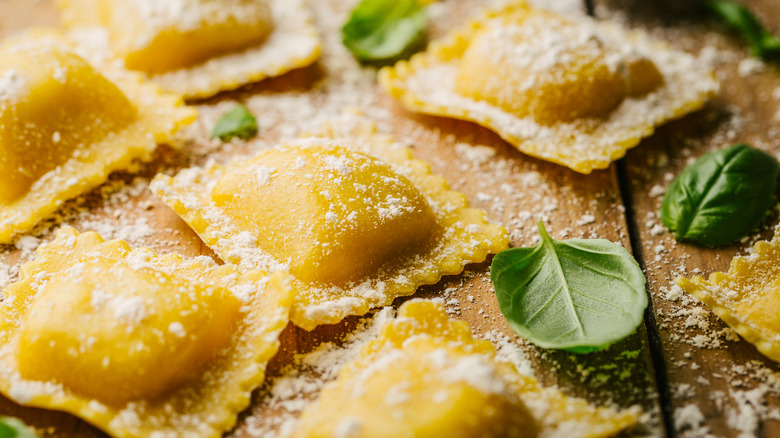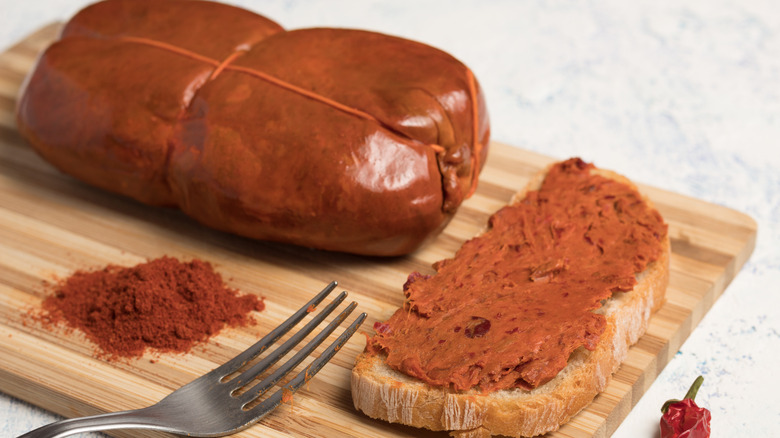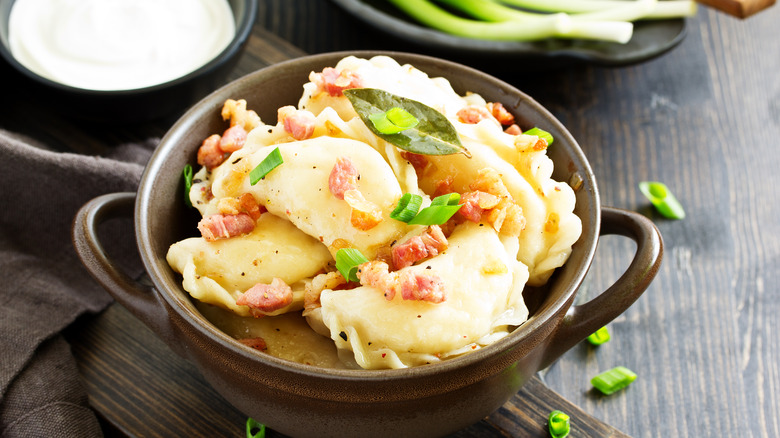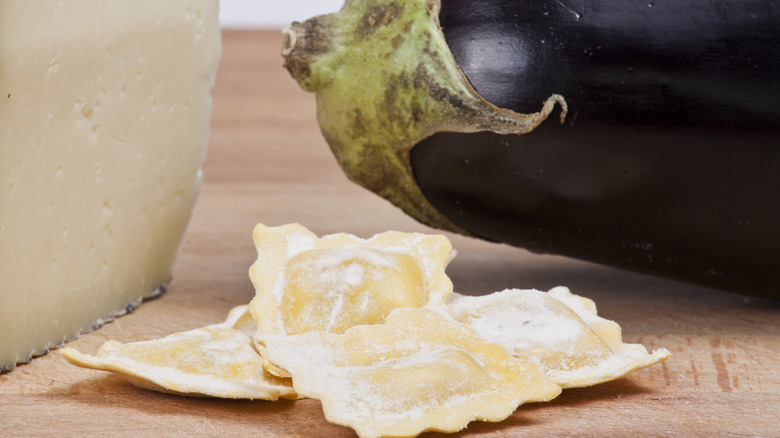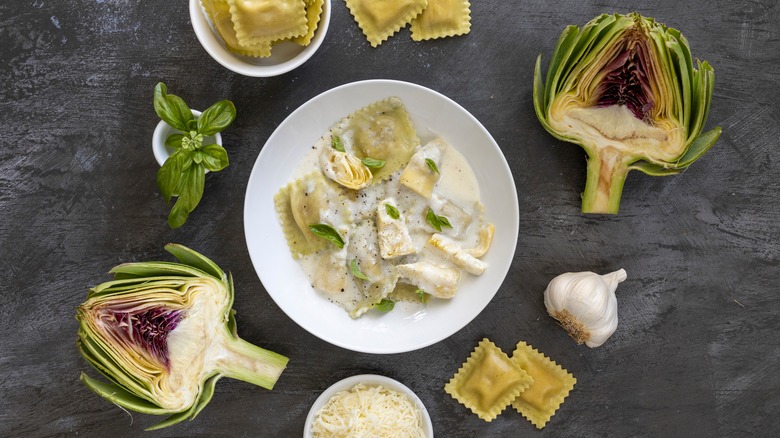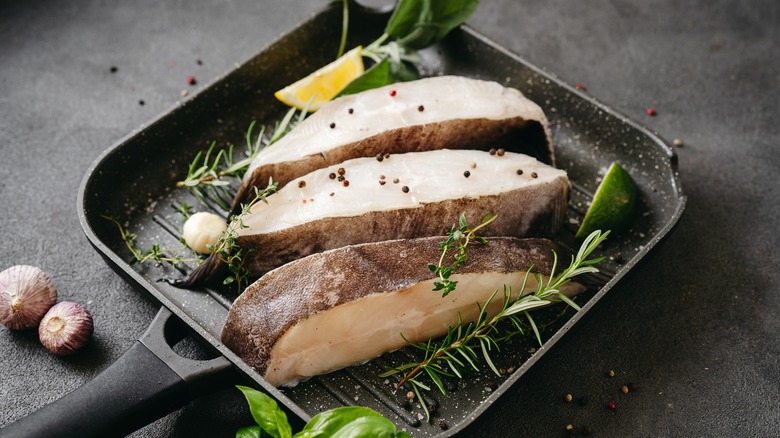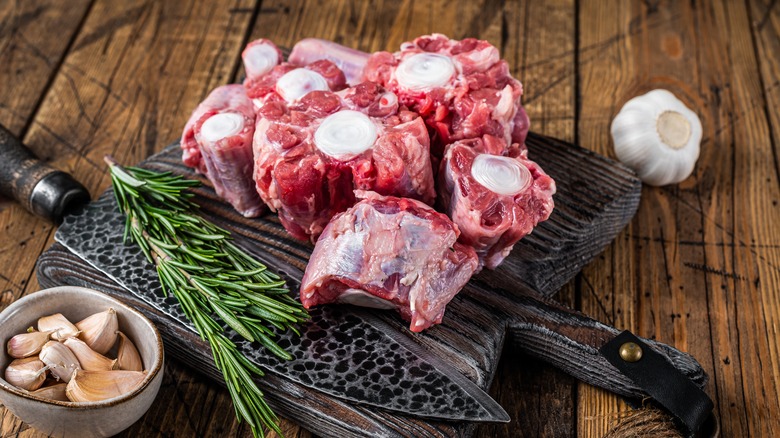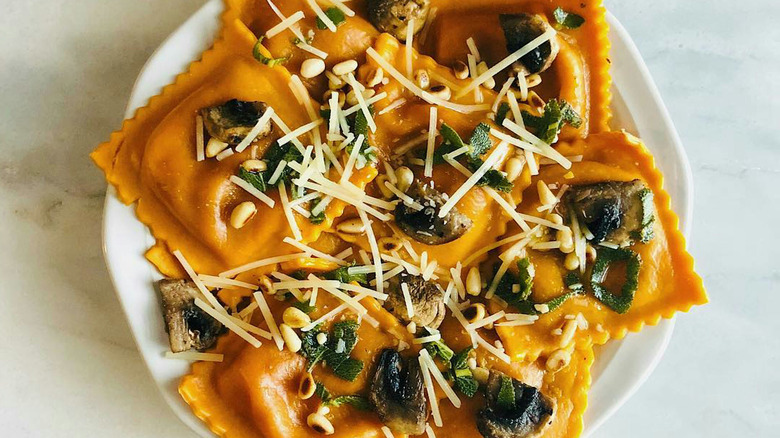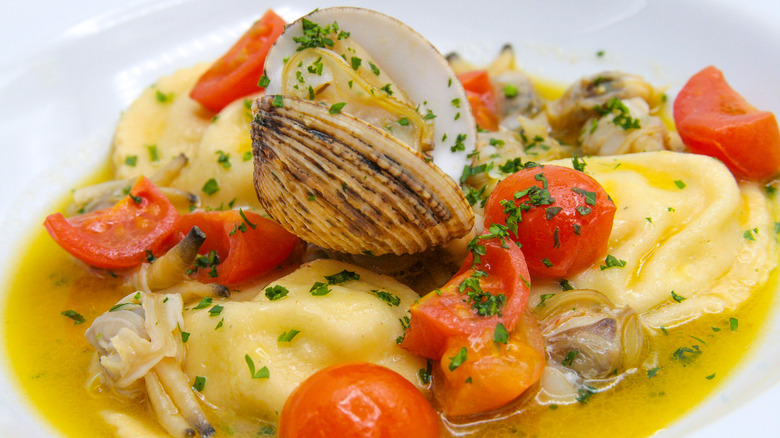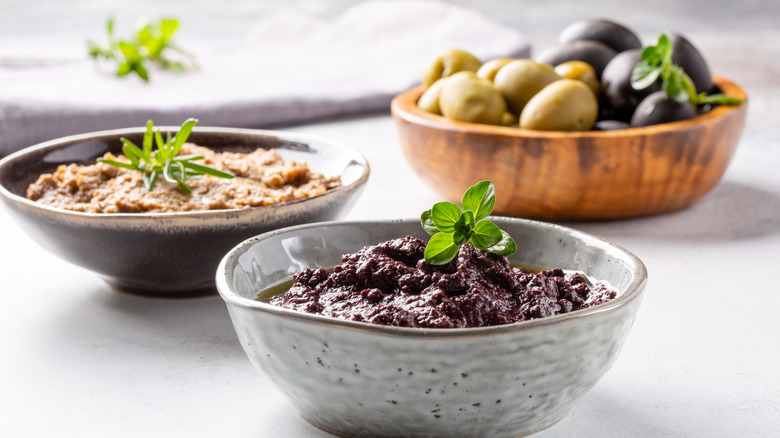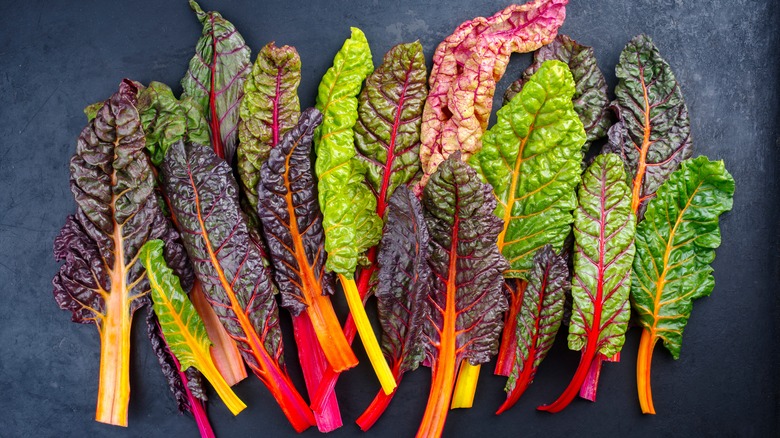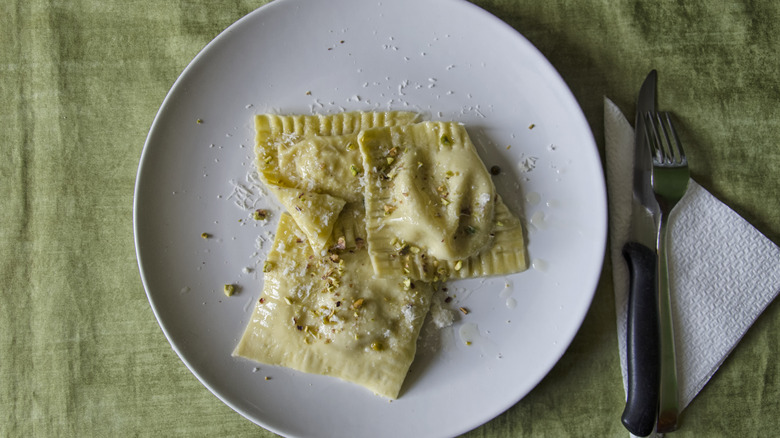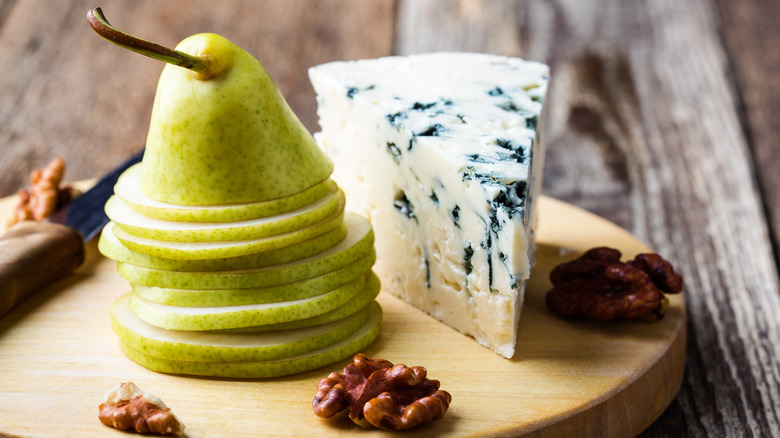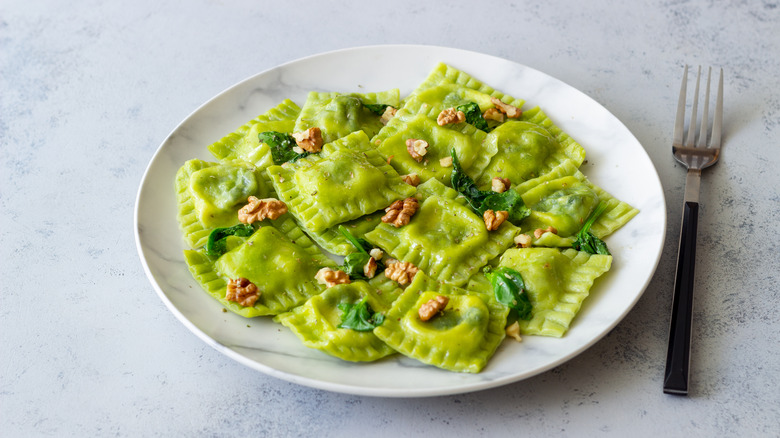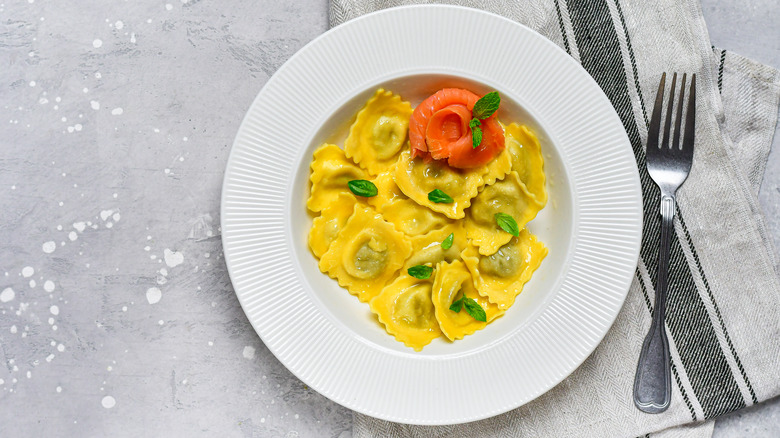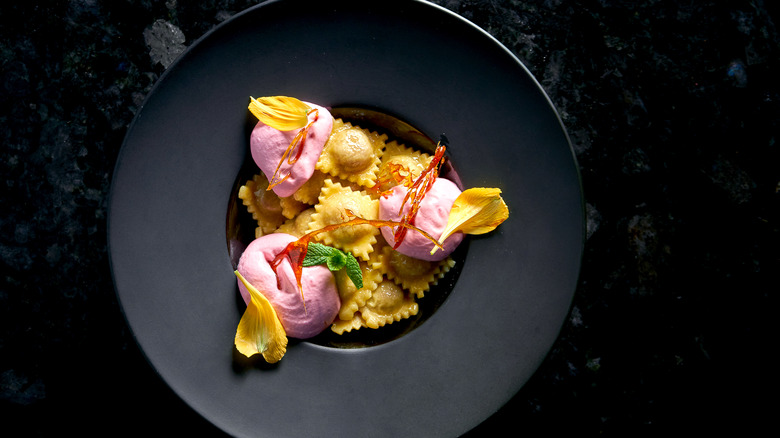15 Secret Ingredients You Should Be Using To Fill Your Ravioli
Making homemade pasta dough is a simple matter of flour, eggs, time, and practice. Once you've mastered the basics, it's time to tackle something more complicated, like ravioli. Traditional ravioli is filled with meat, cheese, or vegetables, and served in sauce or broth. Some ingredients show up often, like ricotta, spinach, and lobster. But ravioli can be stuffed with all sorts of things. A secret ingredient can take things to the next level.
What kind of secret ingredients are we talking about? Generally, things that are associated with wildly different dishes. Smoked salmon, for instance, is closely associated with bagels, but it can be delicious in ravioli. You can also pull from fruits traditionally associated with dessert, like pears. We even suggest pulling in other starchy staples, like potatoes. These secret ingredients aren't just tasty — they're unexpectedly potent, utterly memorable, and entirely unique. Ready to take your ravioli to the next level? From meat to veggies, these 15 fillings will do the job.
1. 'Nduja salami and feta
Italian 'nduja is a spicy sausage made with a generous helping of Calabrian chilies. Unlike hard sausages — think salami and pepperoni — 'nduja is soft and can be spread on crusty bread. We propose it can also be mixed with cheese and stuffed into ravioli.
Since 'nduja is soft, it works well in ravioli. It's especially good when paired with a cheese like feta. Feta is usually associated with Greek cuisine, but it easily slides into its Mediterranean neighbor's foods. Crumbly and intense, it's made with sheep's milk and has a tangy, salty taste that stands up well to spicy 'nduja, making for flavor-packed ravioli. Because feta and 'nduja both have such potent flavors, this ravioli tastes best with a more neutral sauce. A mild, cream-based creation, a simple marinara, or even just olive oil and herbs are ideal for this dish.
If you can't find the real thing, you can make a copycat 'nduja with Calabrian chili paste, cured pork, and a food processor. Take note, though — it will work in a pinch, but it won't be as good as the real thing.
2. Potatoes and pancetta
Potato might seem strange to put in ravioli — after all, isn't it starch-on-starch? But consider this: Potato and pancetta ravioli isn't that far off Polish pierogis. They're delicious in a similar way, too — the pancetta adds texture and a nice salty bite, while the mashed potatoes are soft and fluffy. It's definitely offbeat, but it definitely works.
Pancetta is sold in most international markets, but if you can't find pancetta, you can substitute it with prosciutto or bacon, which are both more readily available. Bacon is the best substitute, as both pancetta and bacon are fatty meats from the pig's belly. If you use prosciutto, the final product will lack some fat, because prosciutto is from the leg. Swapping out pancetta for prosciutto will still give the ravioli some saltiness and texture, but it won't be as rich.
The best potatoes for this dish are russets or Yukon gold because they have a high starch content and make the airiest mashed potatoes. Avoid adding too much butter, because the extra moisture can break the delicate pasta.
3. Roasted eggplant and provolone
Provolone is a popular Italian cheese, but traditionally, it's relegated to sandwiches. If you open yourself up to the notion of putting it in ravioli, though, you'll soon realize it belongs in pasta as well. Provolone's tangy taste and firm texture are an interesting contrast to the tender pasta, and they both play well with roasted eggplant.
Start by choosing a fresh eggplant. Most supermarkets have the globe eggplant, which is great for roasting, but Japanese eggplant works too. You want to pick one with smooth, shiny skin that isn't wrinkled or damaged. It should feel dense and firm. Salt the eggplant to release some bitterness; you can cut it lengthwise or in slices to do this. Then, you drizzle it with olive oil and roast it. Once it's soft, scoop out the insides and pulse them in the food processor with the provolone.
Provolone adds cheesy intensity, yet still lets the flavor of the roasted eggplant shine through. If you want to add a little more bite to your provolone, try using provolone piccante, which has a sharper taste with peppery undertones. You can also pan-fry cubes of eggplant instead of roasting the whole veggie. Some peel the eggplant, while others leave the peel intact and blend it into the cheese mixture. It's up to you.
4. Artichoke and cheese
Many people only eat artichokes in creamy spinach artichoke dip, but artichokes are good in ravioli, too. You can use fresh or canned artichokes for this sort of filling. When fresh artichokes are in season, generally from March to May, they are worth a trip to your local farmers market. Take note: The veggie must be cut and peeled before being steamed and mashed into a filling. But if it's not artichoke season, or using fresh artichokes sounds like too much work, canned artichokes are fine. Most canned artichokes are in brine or olive oil, so they need to be drained and squeezed; too much moisture in a ravioli filling will make it fall apart. But there's no need to rinse off the flavorful brine and spice — just dry them.
As a ravioli filling, artichokes work well with a mild ricotta, perhaps with a handful of Parmigiano Reggiano mixed in for a nutty undertone. A Spanish manchego is an excellent choice, too. These ravioli are great with a simple butter and herb sauce, a light marinara, or even a creamy walnut sauce. The possibilities are endless when it comes to artichoke and cheese ravioli.
5. Halibut and smoked scamorza
Halibut, or any fish, may seem like an odd choice for ravioli filling. But in many coastal parts of Italy, it has long been used in stuffed pasta. Moreover, elite restaurants have experimented with the blend already. Halibut and smoked scamorza ravioli, inspired by a dish at a celebrated New York City eatery, are one such combination of fish and cheese. Halibut has a mild, slightly sweet taste, while smoked scamorza has a rich, smoky, buttery flavor. The two harmonize into something spectacularly savory.
The halibut should be cooked before mixing it with cheese and seasonings. Steaming or baking it is a solid bet. If you pan-fry it, make sure to soak up the excess oil before turning it into filling. Keep the seasoning simple — just salt and pepper — because when it's made into filling, more seasoning is needed, and you don't want to overdo it and lose the delicate balance between fish and smoked cheese.
6. Oxtail
Oxtail may not be the first thing that comes to mind when thinking of ravioli. You may not have ever cooked oxtail, for one thing, and if you have, you've probably only eaten it on its own, or in a stew. But once you get a taste of oxtail ravioli, you'll know it belongs in pasta. Oxtail has traditionally been seen as a throwaway meat, but recently, it has gained status among chefs, and is now a spendier cut. As a result, you might not find oxtail at your local supermarkets and will need to take a trip to the butcher.
The key to cooking oxtail is doing it low and slow. Since oxtail is mostly bone and cartilage with little meat, it cooks down and creates a gelatinous broth. When the meat is fully cooked and so tender that it's falling off the bone, you can mix it with cheese or vegetables and add it to ravioli. Oxtail ravioli is best when a simple sauce is made from the braising liquid and other flavor add-ins, like tomato paste, red wine, or beef stock. All of this work means that oxtail ravioli is not a quick weeknight recipe — consider saving it for a special occasion.
7. Beet and sweet potato
Root vegetables like beets and sweet potatoes are rarely used in ravioli. Their heartiness makes them the base of other dishes, typically, or sides eaten unto themselves. But adding these two bright vegetables to homemade ravioli is a revelation. There are two ways to use beets and sweet potato in ravioli. One is to mix them into the homemade pasta dough; a little beet puree makes a reddish-purple ravioli dough, while sweet potato puree will turn it deep orange. The other is to use them as ravioli filling.
These root vegetables can be combined in a few ways. You can make beet pasta dough with a sweet potato filling, or vice versa. You can also keep it simple by using regular pasta dough and a filling made from both veggies, plus cheese and herbs. Ricotta is a good choice, because it won't overpower the taste and adds a nice pillow-y texture.
A creamy white sauce or tangy red sauce would work with both beet and sweet potato-filled ravioli. If you're using them in the dough, a light butter and herb sauce will allow the ravioli's colors to show through and create a sophisticated presentation.
8. Shellfish
Shellfish like lobster, clams, mussels, shrimp, crab, and oysters are often paired with long pasta noodles, like fettuccini and spaghetti. They're rarely used as a ravioli filling, though — but that should change ASAP. There are a lot of ways to use shellfish in ravioli. You can make lobster ravioli with a creamy crab sauce, oyster ravioli in a spicy shrimp sauce, or any other combination. Use your favorite shellfish pasta dish like spaghetti alle vongole or frutti di mare as inspiration.
You can keep this ravioli dairy-free, add a mild cheese for texture, or just sprinkle Parmigiano Reggiano on top for a nutty finish. Because fresh shellfish can be expensive and isn't always available, you might also use a tinned option, which can be just as good.
9. Olive tapenade and goat cheese
Olive tapenade is usually found on a charcuterie board and not in a pasta dish. With a little work, though, it can make an excellent ravioli filling. It does, admittedly, take a little getting used to, and can be a shock at first bite. But ravioli with a burst of salty, tangy flavor is unique enough to impress even the most jaded palates.
Olive tapenade is made with olives, garlic, capers, garlic, and seasonings. If you aren't sure which type of tapenade to use, keep in mind that green olives lean bitter, black olives lean sweeter, and Kalamata olives have a smoky, fruity taste. You can find tapenade in most supermarkets or international stores.
Mixing the bright, briny olive tapenade with velvety goat cheese takes this pasta to an even more delicious place. For an elegant dinner, dress this ravioli with a light tomato sauce or olive oil and herbs. Keeping the sauce on the lighter side will keep the flavors balanced.
10. Swiss chard and gruyere
Swiss chard doesn't get as much attention as greens like spinach, kale, and arugula. But it should, especially when paired with gruyere and stuffed into ravioli. Gruyere cheese has a unique flavor, both milky and nutty; you might have seen it on sandwiches, melted into a Swiss fondue, or used in a creamy pasta sauce. It's not typically stuffed into ravioli, though, which makes this filling doubly unique. Classic spinach and ricotta ravioli can step aside: It's time to let the Swiss chard and gruyere steal the show.
For creamy and soft ravioli, choose a lightly aged gruyere. For a sharper taste with fruity undertones, reach for an aged option. Both work well with chard's sharp, spicy flavor. For a heartier meal, serve this ravioli with a meaty ragu or a creamy sauce with spicy Italian sausage. You can also keep it vegetarian and serve it with a light marinara.
11. Pistachio and ricotta
Most people are familiar with pistachios as a crunchy snack, or have eaten pistachio-flavored desserts. But when these little green nuts are ground, they make a surprisingly elegant ravioli filling. Ricotta is an excellent partner to pistachios' unique flavor: Earthy, umami-rich pistachios mixed with creamy, salty ricotta cheese feels like a tasty little secret.
Start with ground pistachios, which you can find at international markets or Italian specialty food stores. Ricotta is easy to find in any supermarket, but it's just as easy to create at home. Making homemade ricotta may seem daunting, but all you need is whole milk, lemon juice, salt, cheesecloth, and a thermometer. This extra step will make your pistachio ricotta ravioli taste like it came from a particularly innovative Sicilian kitchen.
The best sauce for this dish is a light marinara or simple butter and herbs. Steer clear of meat-based sauces — they're too heavy for this delicate dish.
12. Gorgonzola and pears
Gorgonzola cheese is a polarizing food that some adore and others ... well, not so much. But this Italian blue cheese isn't anywhere near as intense as Roquefort, the pungent French blue cheese. Moreover, when stuffed into doughy ravioli squares alongside sweet, acidic pears, gorgonzola loses its sharpness and turns into something mouthwatering. Yet even though it's easy to find this flavor combo on a salad or pizza, you probably won't find it in ready-made ravioli. Time to take matters into your own hands.
Anjou pears are the best choice for ravioli because they're sweet and firm and stand up well to being roasted. However, Anjou pears are considered winter pears, so they may not always be available. The second-best choice are sweet Bartlett pears. Mixing fresh pears with dried ones is also an option for this ravioli filling. The pears and cheese dominate this dish, so a light sauce is ideal. The best way to serve it is with olive oil or butter and a sprinkle of Parmigiano Reggiano.
13. Wild greens
Searching the forest for ravioli fixings may seem like a risky idea, but freshly foraged wild greens can be an excellent filling. There are no set ingredients to this dish; its end result depends on the season and what is ready to forage. Radicchio, parsley, garlic scapes, nettles, and all manner of other greens might appear in this ravioli. This is part of the attraction, though — this ravioli will always surprise you.
Foraging is fun, but don't do it if you aren't 100% confident in your plant identification skills. Consider going to a farmer's market instead, where foraged greens are often on offer. Mix your greens with ricotta, to curb their intensity. The sauce can be whatever you like, from a hearty red ragu to a velvety Alfredo. A traditional green pesto pumps the veggie factor up even higher. Serve with a sprinkle of crumbly cheese.
14. Smoked salmon
Smoked salmon is traditionally associated with bagels. It does have a history in pasta – smoked salmon in pasta sauce can be a magical thing — but the pink fish is even better when neatly tucked into a ravioli. Smoked salmon is widely available and is often sold pre-seasoned. The sauce you use will determine whether you stick with classic smoked salmon or one with added flavoring.
Ricotta and cream cheese pair well with smoked salmon, the latter being the fish's classic partner. A simple sauce with herbs like dill, oregano, and briny capers will highlight the salmon's flavor. A creamy lemon pepper sauce is a good choice, too. If smoked salmon isn't available, canned salmon is another good option (and often a more economical one). Remove any small bones so you don't get an unwanted surprise in your ravioli.
15. Sweet ravioli
Sweet ravioli might seem crazy, but it's actually fairy sensible. How different is cannoli (a pastry shell filled with ricotta) from ravioli (a pasta shell frequently filled with ricotta) when we really think about it? Some chefs are already wise to this, and their creations are a major inspiration. In many of their sweet ravioli recipes, cocoa powder is incorporated into the dough. Other versions are fried and served with powdered sugar and cinnamon, or drizzled with honey. Some daring options combine traditional pasta dough with a sweet filling.
It's not just individual chefs making sweet ravioli, either — the Italians have been hip to it for a long time. In Sicily, sweet ravioli is made with chocolate and ricotta cream filling and served with grated lemon zest for a sweet, bright finish. In Campania, they are filled with a mix of chestnuts, chickpeas, chocolate, and cinnamon, with a splash of sweet liquor. Near the border with Austria, sweet ravioli are popular at Christmas time, and are filled with prunes, figs, sugar, and ricotta. Cooks in Lombardy take a sweet-and-sour approach, with fillings made with amaretti biscuits, pears, almonds, and raisins.
Try a classic recipe, or get creative with your sweet ravioli. Experiment with chopped nuts, dried fruit, Nutella, or caramel. Serve with fresh fruit or fruit compote, or even a little gelato.
